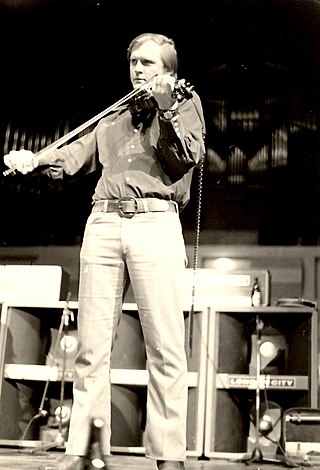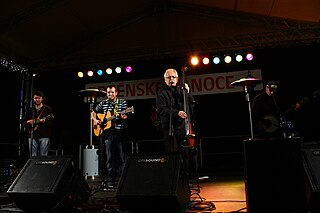The banjo is a stringed instrument with a thin membrane stretched over a frame or cavity to form a resonator. The membrane is typically circular, in modern forms usually made of plastic, originally of animal skin.

William Smith Monroe was an American mandolinist, singer, and songwriter, and created the bluegrass music genre. Because of this, he is often called the "Father of Bluegrass".

Bluegrass music is a genre of American roots music that developed in the 1940s in the Appalachian region of the United States. The genre derives its name from the band Bill Monroe and the Blue Grass Boys. Like mainstream country music, it largely developed out of old-time music, though in contrast to country, it is traditionally played exclusively on acoustic instruments and also kept its roots in traditional English, Scottish and Irish ballads and dance tunes, as well as incorporating blues and jazz. It was further developed by musicians who played with Monroe, including 5-string banjo player Earl Scruggs and guitarist Lester Flatt. Bill Monroe once described bluegrass music as, "It's a part of Methodist, Holiness and Baptist traditions. It's blues and jazz, and it has a high lonesome sound."
Skiffle is a genre of folk music with influences from American folk music, blues, country, bluegrass, and jazz, generally performed with a mixture of manufactured and homemade or improvised instruments.

Old-time music is a genre of North American folk music. It developed along with various North American folk dances, such as square dancing, contra dance, clogging, and buck dancing. It is played on acoustic instruments, generally centering on a combination of fiddle and plucked string instruments, most often the banjo, guitar, and mandolin. Together, they form an ensemble called the string band, which along with the simple banjo–fiddle duet have historically been the most common configurations to play old-time music. The genre is considered a precursor to modern country music.
Folk punk is a fusion of folk music and punk rock. It was popularized in the early 1980s by The Pogues in England, and by Violent Femmes in the United States. Folk punk achieved some mainstream success in that decade. In more recent years, its subgenres Celtic punk and Gypsy punk have experienced some commercial success.

Flatt and Scruggs were an American bluegrass duo. Singer and guitarist Lester Flatt and banjo player Earl Scruggs, both of whom had been members of Bill Monroe's band, the Bluegrass Boys, from 1945 to 1948, formed the duo in 1948. Flatt and Scruggs are viewed by music historians as one of the premier bluegrass groups in the history of the genre.

Druhá Tráva is a Czech bluegrass band originally formed in Czechoslovakia in 1991 by Robert Křesťan and Luboš Malina. As of 2021, they have released thirteen studio albums, four live albums, two compilations, as well as a number of side projects. They have been described as evolving from underground musicians who subverted Communism to international artists who "upend convention".

Tramping is a movement in the Czech Republic and Slovakia that incorporates woodcraft, hiking/backpacking/camping and scouting, styled on the culture of the United States, especially the Wild West. Tramping is also associated with a distinctive style of clothing, hiking culture, slang, and music known as Czech tramping music.

Byron Douglas Berline was an American fiddle player who played many American music styles, including old time, ragtime, bluegrass, Cajun, country, and rock.
Americana is an amalgam of American music formed by the confluence of the shared and varied traditions that make up the musical ethos of the United States of America, with particular emphasis on music historically developed in the American South.
Traditional bluegrass, as the name implies, emphasizes the traditional elements of bluegrass music, and stands in contrast to progressive bluegrass. Traditional bluegrass musicians play folk songs, tunes with simple traditional chord progressions, and on acoustic instruments of a type that were played by bluegrass pioneer Bill Monroe and his Blue Grass Boys band in the late 1940s. Traditional bands may use their instruments in slightly different ways, for example by using multiple guitars or fiddles in a band.

William Bradford "Bill" Keith was a five-string banjoist who made a significant contribution to the stylistic development of the instrument. In the 1960s he introduced a variation on the popular "Scruggs style" of banjo playing which would soon become known as melodic style, or "Keith style". He was inducted into the International Bluegrass Music Hall of Fame in 2015.

Mladý svět is a popular weekly magazine published in Czechoslovakia from 1959 until 1989, and later in the Czech Republic until 2005, when it was merged into the magazine Instinkt. It contained photographs, editorials, comics, and other works. Mladý svět was revived in 2021 and continues to be published as of 2024.

Poutníci is a Czech bluegrass ensemble, heavily influential in the second wave of the genre.

Bluegrass mandolin is a style of mandolin playing most commonly heard in bluegrass bands.

Kukuruza is a Russian band who progressed from a student startup to become an international touring act in the early 1990s.
Although it is commonly thought that bluegrass music originated in the Appalachian region of the United States, it has roots in other countries, as well. Over the past 90 years Bluegrass music has spread from the hills of Appalachia in the United States to create small communities of musicians and listeners in over 62 countries in Europe. The use of indigenous musical instruments and traditional folk music that originated in foreign folk cultures have allowed bluegrass to become popular in foreign countries.











